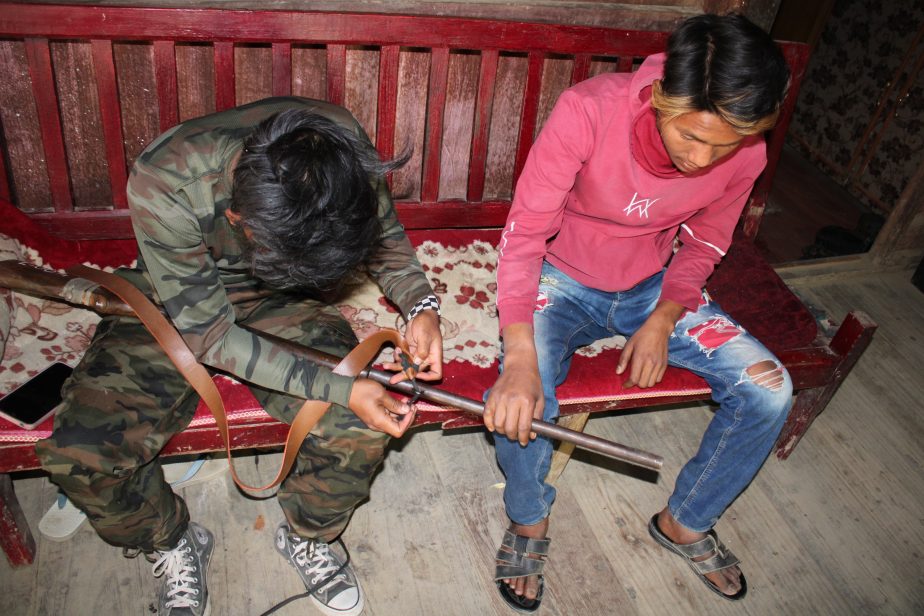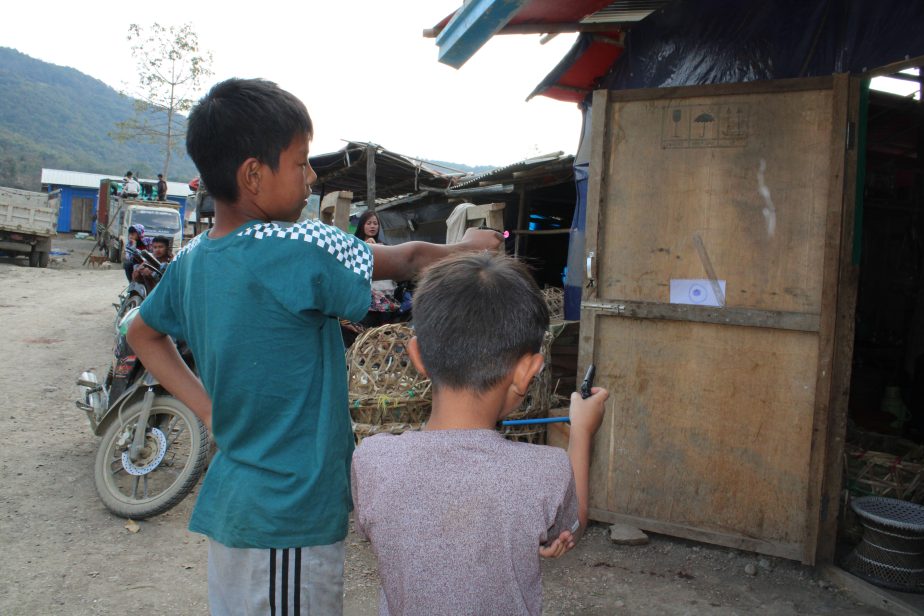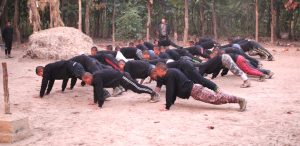As Myanmar’s civil war grows in ferocity, children are getting caught in the crossfire in myriad ways. While many children have been killed in air strikes or shot dead by junta forces on the suspicion that they are part of resistance groups, some have joined the fighting against the junta.
This involvement of children in Myanmar’s Spring Revolution has prompted the opposition National Unity Government (NUG) to instruct resistance groups to abstain from training and engaging them in the war against the military junta.
“The NUG has strictly prohibited PDFs [People’s Defense Forces] from engaging children under 18 years of age to join any operations or military training,” Secretary to the Ministry of Defense in the NUG Naing Htoo Aung told The Diplomat. “Each unit officer and division commander has been given appropriate instructions. If any unit commander finds minors being given any military responsibilities, they are to take immediate action.”
PDFs are armed groups affiliated with the NUG that were formed all over the country after the military staged a coup in Myanmar on February 1, 2021.
The NUG directive on children came in the wake of a spate of reports about minors’ association with resistance groups and their deaths at the hands of the military, a functionary of the NUG said. He added that the NUG adheres to the United Nations guidelines that prohibit the involvement of children as combatants in armed conflict.
Over the past two years, there have been several reports of children being killed by the regime forces on suspicion of being attached to the resistance groups. Last year, a U.N. committee warned that as many as 382 children were murdered by the military and its allies, and another 142 tortured since the coup two years ago.
The strife in Myanmar had displaced over half a million children as of November last year, as per an estimate by Save The Children, with the highest numbers in Sagaing Region, Kayah, and Kayin. Educational institutes have remained shut in many parts of the country, including Chin State and Sagaing Region, owing to the disturbed conditions.
Efforts made by the NUG or local committees such as the Thantlang Public Administration to start schools in makeshift conditions have succeeded in drawing a large number of children, but many among them continue to be deprived of education. At the IDP camp in Salen in Chin State, I found three children who are not attending school. It is mainly from this section of children that some have landed at the camps of the resistance groups.
During my travels in Chin State and Sagaing Region between January and March this year, I observed a varied scenario on the engagement of children by the resistance groups and their response to the directive issued by the NUG. Some resistance groups strictly prohibit child fighters, but other groups continue to recruit them.
NUG-Affiliated Groups Prohibit Child Fighters
PDFs and organizations affiliated with the NUG in Chin State and Sagaing Region have accepted the NUG’s directive and prohibited children from getting trained or engaged in operations against the junta. This is a departure from the practice these groups adopted soon after they emerged in the months following the coup, when children were allowed into their ranks as there was a dire need for fighters.
A middle-ranking functionary of the Chin National Army (CNA) pointed out that his organization has always followed the Geneva Convention of 1949, which forbids states and non-state armed groups from recruiting or using children under the age of 15 in armed conflict.
I spotted some children at the camps of the Kalay PDF and the Chin National Defense Force (CNDF) at Kalay in Sagaing Region. But they have been forbidden from participating in drills and operations against the military. They are engaged in non-military work at the camps.
Pu Vela, a founder member of the Kalay PDF, admitted that there “were many children” in the group soon after it was founded in 2021. “The process of shifting them from the camps has started after the NUG’s directive,” he said.
PDFs active at the border district of Tamu in Sagaing Region have also adhered to the norms laid down by the NUG. In some cases, as Tamu parliamentarian Thang Sei explained, there were cases of children who refused to leave the camps after they were denied access to training. “We convinced them to get enrolled in the education program of the NUG and told them strictly that they would be trained only after they reach 18 years of age,” he said in an interview at Tamu on March 24.

A child combatant (left) examines his weapon at Haimual in Chin State, which is defended by the Mountain Eagle Defense Force. Photo by Rajeev Bhattacharyya.
Around 5 miles from the Tiau River on the border between Myanmar and the Indian state of Mizoram at Champhai, a meandering and dusty road leads to the picturesque village of Haimual, which was raided by the military on August 14 of last year. Two children were killed and 22 houses burned. Fearing further violence by the military – its camp is located on a hill top just 3 miles away, which is visible from the village and from Zokhawthar on the Indian side – the residents of the village relocated to a refugee camp at Zokhawthar across the river in Champhai.
A month after the military raid on Haimual, residents of the village formed a resistance squad called the Mountain Eagle Defense Force (MEDF). The MEDF was trained for a month by the CNA at its military headquarters called Camp Victoria, located about 60 miles south of Haimual.
In the MEDF squad of 30 or so fighters is Emo Thang (name changed), whose parents and siblings have relocated to a refugee camp in Mizoram. But Emo decided to chart a different route for himself by joining the resistance group and getting involved in defending his village against further attacks by the military.
Armed with a 12-bore gun, young Emo was seated in a house with a young adult when I met him at Haimual on January 14. He understood English but was unable to speak in the language fluently. His curt replies to a few questions I posed to him were translated by an elderly functionary of the group.
“What prompted you to join Mountain Eagle Defense Force?” I asked.
“The village must be defended. I will stay here rather than at the refugee camp at Champhai,” he replied.
“Was it your own choice to join the group?”
“Yes.”
“Do you think you will be able to defend the village against more attacks?”
“Yes. We are fully prepared.”
“Ok. Were you studying before the village was abandoned?”
“Yes.”
“Will you go back to school after the war comes to an end?”
“Certainly.”
“And what do you think will be the outcome of the war? How long will it last?”
“We will win.”
“When?” I asked and repeated the question.
There was no answer from him.
I understood that he was reluctant to answer more questions. He grabbed the gun, stood up, and walked out of the house.
Other Groups Continue to Recruit Children to Fight
Emo’s case is symbolic of the situation with some resistance groups in the Sagaing Region and Chin State that are not affiliated with the NUG. They continue to engage children in combat roles. I spotted some children in resistance groups’ camps and along the routes I traveled in both regions.
I noticed a child of around 15 years of age with an MK-12 assault rifle in a group of eight heavily armed fighters at a check post manned by PDF Zoland around 15 miles after crossing Tedim in Chin State on the narrow and pothole-ridden mountainous road to Kalay.
PDF Zoland is one of the smaller resistance groups in Chin State, constituted toward the end of 2021 and trained by the CNA. Besides battling the junta forces, this group has the additional task of defending itself from the Zomi Revolutionary Army–Eastern Command (ZRA-EC), which has a wing in the contiguous Indian state of Manipur and is in an alliance with the military.
When our motorbike stopped at the check post, a child combatant posed a question to me in his language. He giggled after my associate (who drove the motorbike) replied saying that I was an academic from Mizoram on an assignment to study the situation at Kalay. He noted the registration number of the vehicle and allowed us to proceed on our journey.
In Chin State, I saw a child near Tlangpi village on the road between Camp Victoria and Thantlang. He was carrying a single-barrel rifle. Later, when I asked a CNA functionary about the group the child was affiliated with, he replied that he could be part of a local defense force but not the CDF Thantlang, which was another organization active in the region that was in an alliance with the CNA.
At Tamu and neighboring places in Sagaing Region such as Monywa, some resistance squads have enrolled children in their ranks. This was revealed to me by three resistance fighters I met at Tamu and some refugees at the contiguous Indian border town of Moreh in Manipur between March 21 and 26. Some of them hail from villages that were burned down by the military. Their families are either at the IDP camps in Myanmar or have relocated to Manipur.
Then there are also children who are not associated with the groups but are engaged in different capacities with the resistance movement. At a village near Letpanchaung in Kalay, I met a child at a weapons manufacturing unit that produces landmines and pistols.

Children practice target-shooting at a refugee camp in Zokhawthar in India. Photo by Rajeev Bhattacharyya.
During a stroll around the camps at Zokhawthar on January 16-17, I interacted with refugees. Our conversations threw up fascinating aspects about their lives, backgrounds, and the circumstances that compelled them to leave their homes. The despondent atmosphere was occasionally interrupted by children playing at the camps.
At the five camps at Zokhawthar, most of the children attend schools established by the Mizoram government or private agencies or run with the support of the NUG. Some among them play football in the evening while others were helping their families run small shops to generate income.
An unusual sight greeted me at Camp No. 3: two children practicing target shooting with toy pistols at a hut where a family from Haimual lived. Silently, without disturbing them, I watched them and the delight on their faces whenever they were able to hit the small circle on a white paper pasted on the wooden door of the hut. They stopped after I clicked a few photographs. I asked one of them to pose for me for an extra picture. Soon they shifted their practice to a different location near another hut.
Vung Sian Huai, a teacher at the camp, informed me that both the children attended the NUG-affiliated school that taught students from grades 1 to 10. There are 106 students who attend the school and they comprise the majority of the children at the camp, she said, although there were some who did not want to go to school.
The disinclination toward attending schools was visible at Kalay as well.
“Children do not want to go to school anymore. Classes were disrupted during the pandemic when schools had to shut down,” said Sir John, a prominent Pa Ka Pha (Local Defense Force) leader in Kalay. “We are putting in efforts to bring as many children as possible to the schools that have been started,” he told me.
The phenomenon of child soldiers is not new in Myanmar. This has been an ongoing trend over the past several decades.
For several years now, Myanmar figures in a list of countries where children are recruited by both the government forces and ethnic armed organizations (EAOs). Last year, the U.N. Secretary-General’s Annual Report on Children and Armed Conflict named the junta and four EAOs as recruiters of children to their ranks.
Among the EAOs listed by the U.N. are groups such as the Kachin Independence Army (KIA), Karen National Liberation Army (KNLA), and Karenni Army (KA) that are actively fighting the military regime. It is not known if they have now accepted the NUG directive and prohibited children from participating in operations against the regime forces.
With no indication of the war ending soon, it is likely that children will continue to be engaged by the resistance groups that operate independently and are not affiliated with the NUG.
The coup has fueled unprecedented opposition at different levels and places in the country against the military regime creating ample space for the participation of people of different age groups in the movement.

































